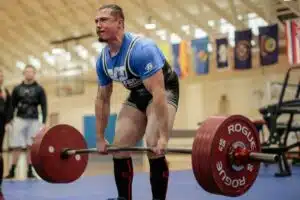Many times, we see in social networks how influencers upload to their profiles “the best exercises” to increase muscle mass, of which, many leave a lot to be desired at the level of biomechanics, fiber involvement, etc. But if you want your workout, like a good meal to be excellent, the exercise selection is only the ingredients you should use, what will make the difference will be how you use these ingredients (exercises).
The training variables are the steps to follow that as a good chef you must know how to use. The ingredients alone will not be enough for you at all.
If you want to become a top chef and know all the variables to take into account to increase your muscle mass, read on!
What are these training variables?
As we already know, resistance training is the most effective training for the production of muscle hypertrophy (Grgic, 2019). There are three factors that we must know when planning our workouts. The three stimuli or mechanisms that produce muscle hypertrophy are: mechanical tension (the main one), metabolic stress and muscle damage.

Figure 1. Main mechanisms of hypertrophy (@rubrs_go)
The Volum of Training
The first of these variables that we must take into account is the volume of training. It can be defined as the number of sets per muscle group and number of repetitions multiplied by the load lifted or load volume that would reflect the total kg lifted.
There are three concepts in relation to the volume of training, that is, the number of series you perform per week, which you must take into account.
Maintenance Volume (MV)
Minimum amount of training volume that a person can perform without getting worse, without reducing their particular situation.
Minimum effective volume (MEV)
Minimum amount of training volume that a person can perform to have a measurable improvement, that is, increase hypertrophy in a period of time that the change is relevant. In untrained people 5weekly series, in trained people 10 group / weekly series
Maximum volume recoverable (MVR)
Maximum amount of training volume a person can do

Figure 2. Training volume (Schoenfeld et al, 2016)
The Intensity
On the other hand, we have the intensity that refers to the degree of muscle tension produced by a muscle or muscle group, with respect to its maximum voluntary contraction. In other words, the degree of effort that a particular exercise produces.
There are several ways to express this intensity and measure fatigue:
According to the repetitions in reserve (RIR)
That is, those repetitions that you could do, but you do not get to make few stops before the series. For example, if you usually perform a squat with a back bar in which you load 20kg on each side and perform 10 repetitions knowing that you could have done 3 more, you would have performed the squat at RIR 3.
The RPE is a scale of perceived effort
That is, how much effort an exercise of 1-10 supposes you. Normally, RIR and RPE have a very high correlation.

Figure 3. RIR and RPE Infographic (@rubrs_go)
It was found that the load is not really relevant as long as you work with a high effort character. In order to gain greater muscle hypertrophy, we should train with a RIR 3-4 at least and avoid training at the fault.
Working with a load of 20%RM (60-70reps maximum), showed to produce less muscle hypertrophy than working with 40, 60 or 80% RM. No differences were found in hypertrophy when training with any of these last three intensities (Lasevicius, 2018)
Training frequency
Training frequency is the number of times an event occurs in a given period of time (usually a week). Usually, training frequency alone will not have an effect on muscle hypertrophy, but it will be a very useful tool for increasing training volume.
If the total volume is the same, the same improvements in muscle hypertrophy will be achieved regardless of their weekly distribution (Schoenfeld, 2019).
How many repetitions and sets do you need to increase muscle mass?
Now that we know the training variables and have a good foundation, let’s go into the kitchen to prepare our menu.
How many series are necessary and optimal?
In 2010, Krieger showed that performing 2-3 sets of a muscle group causes greater muscle hypertrophy than performing just 1 set. In turn, he also found that there was no significant difference in hypertrophy when performing 4-6 series compared to 2-3 series, thus deducing that as the 6 series are reached and exceeded, the hypertrophy curve flattens.
Performing more than one series produces 40% more hypertrophy than performing a single series. There was no difference between performing 4-6 or 2-3 sets per exercise. The strength gains are greater and the OPTIMAL is when 2-3 sets are performed per exercise that when a single series is performed, once these are exceeded, there is no additional benefit. In addition, performing +10 effective weekly sets per muscle group produced better results than performing between 5-9 and <5 sets, but it will depend on the muscle group we are talking about. (Schoenfeld, 2017)
As for the repetitions, although it has been shown that the range of repetitions where muscle hypertrophy is achieved is very wide (6-30 repetitions), Schoenfeld, Contreras et al. (2014) divided two groups. One of them would train with series with 2 to 4 repetitions, while the other group trained with series at 8-12 reps (classic range). Greater hypertrophy was observed in group 2.
In summary
The range of effective repetitions of between 6-30 with RIR < o = 4 would be effective. As for the series, performing 2 to 3 series would be optimal. In short, because for each person will do better a volume of training that will be different from that of another, we must consider these general recommendations as a basic guideline from which to modify factors so that the training adapts to each one
Rubén Redondo Sánche
Bibliography
- Grgic, J., Mcllvenna, L. C., Fyfe, J. J., Sabol, F., Bishop, D. J., Schoenfeld, B. J., & Pedisic, Z. (2019). Does Aerobic Promote the Same Skeletal Muscle Hypertrophy as Resistance Training? A Systematic Review and Meta-Analysis. Sports medicine (Auckland, N.Z.), 49(2), 233–254.
- Krieger J. W. (2010). Single vs. multiple sets of resistance exercise for muscle hypertrophy: a meta-analysis. Journal of strength and conditioning research, 24(4), 1150–1159. https://doi.org/10.1519/JSC.0b013e3181d4 d436
- Schoenfeld, B. J., Ogborn, D., & Krieger, J. W. (2017). Dose-response relationship between weekly resistance training volume and increases in muscle mass: A systematic review and meta-analysis. Journal of sports sciences, 35(11), 1073–1082. https://doi.org/10.1080/02640414.2016.121 0197
- Lasevicius, T., Ugrinowitsch, C., Schoenfeld, B. J., Roschel, H., Tavares, L. D., De Souza, E. O., Laurentino, G., & Tricoli, V. (2018). Effects of different intensities of resistance training with equated volume load on muscle strength and hypertrophy. European journal of sport science, 18(6), 772–780. https://doi.org/10.1080/17461391.2018.145 0898
- Schoenfeld, B. J., Contreras, B., Willardson, J. M., Fontana, F., & Tiryaki-Sonmez, G. (2014). Muscle activation during low- versus high-load resistance training in well-trained men. European journal of applied physiology, 114(12), 2491–2497. https://doi.org/10.1007/s00421-014-2976-9
- Schoenfeld, B. J., Grgic, J., & Krieger, J. (2019). How many times per week should a muscle be trained to maximize muscle hypertrophy? A systematic review and meta-analysis of studies examining the effects of resistance training frequency. Journal of sports sciences, 1-10. 7
- Schoenfeld, B. J., Grgic, J., Van Every, D. W., & Plotkin, D. L. (2021). Loading Recommendations for Muscle Strength, Hypertrophy, and Local Endurance: A Re-Examination of the Repetition Continuum. Sports (Basel, Switzerland), 9(2), 32. https://doi.org/10.3390/sports9020032
- Schoenfeld, B. J., Grgic, J., Ogborn, D., & Krieger, J. W. (2017). Strength and Hypertrophy Adaptations Between Low- vs. High-Load Resistance Training: A Systematic Review and Meta-analysis. Journal of strength and conditioning research, 31(12), 3508–3523. https://doi.org/10.1519/JSC.000000000000 2200












